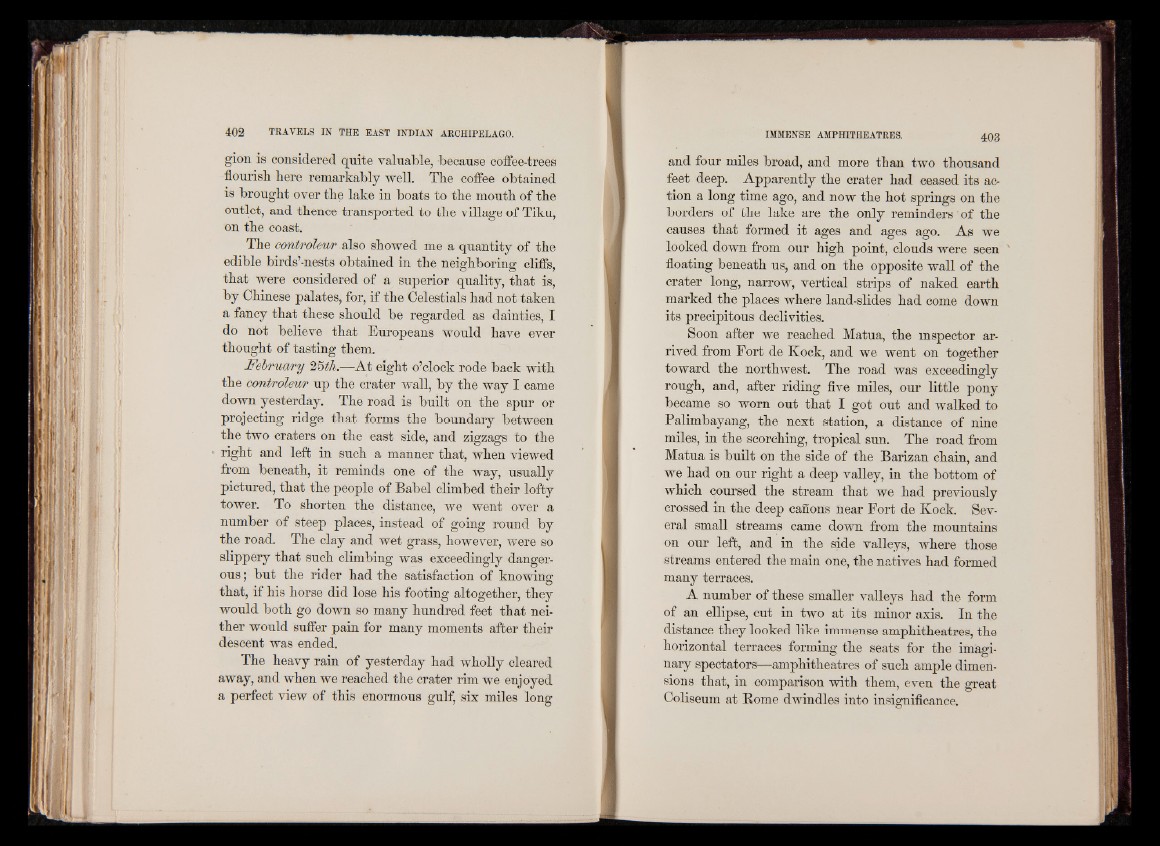
gion is considered quite valuable, because coffee-trees
flourish here remarkably well. The coffee obtained
is brought over the lake in boats to the mouth of the
outlet, and thence transported to the village of Tiku,
on the coast.
The controleur eUso showed me a quantity of the
edible birds’-nests obtained in the neighboring cliffs,
that were considered of a superior quality, that is,
by Chinese palates, for, if the Celestials had not taken
a fancy that these should be regarded as dainties, I
do not believe that Europeans would have ever
thought of tasting them.
February 25th.—At eight o’clock rode back with
the controleur up the crater wall, by the way I came
down yesterday. The road is built on the spur or
projecting ridge that forms the boundary between
the two craters on the east side, and zigzags to the
right and left in such a manner that, when viewed
from beneath, it reminds one of the way, usually
pictured, that the people of Babel climbed their lofty
tower. To shorten the distance, we went over a
number of steep places, instead of going round by
the road. The clay and wet grass, however, were so
slippery that such climbing was exceedingly dangerous
; but the rider had the satisfaction of k n ow in g
that, if his horse did lose his footing altogether, they
would both go down so many hundred feet that neither
would suffer pain for many moments after their
descent was ended.
The heavy rain of yesterday had wholly cleared
away, and when we reached the crater rim we enjoyed
a perfect view of this enormous gulf, six miles long
and four miles broad, and more than two thousand
feet deep. Apparently the crater had ceased its action
a long time ago, and now the hot springs on the
borders of the lake are the only reminders of the
causes that formed it ages and ages ago. As we
looked down from our high point, clouds were seen
floating beneath us, and on the opposite wall of the
crater long, narrow, vertical strips of naked earth
marked the places where land-slides had come down
its precipitous declivities.
Soon after we reached Matua, the inspector arrived
from Fort de Kock, and we went on together
toward the northwest. The road was exceedingly
rough, and, after riding five miles, our little pony
became so worn out that I got out and walked to
Palimbayang, the next station, a distance of nine
miles, in the scorching, tropical sun. The road from
Matua is built on the side of the Barizan chain, and
we had on our right a deep valley, in the bottom of
which coursed the stream that we had previously
crossed in the deep canons near Fort de Kock. Several
small streams came down from the mountains
on our left, and in the side valleys, where those
streams entered the main one, the natives had formed
many terraces.
A number of these smaller valleys had the form
of an ellipse, cut in two at its minor axis. In the
distance they looked like immense amphitheatres, the
horizontal terraces forming the ° seats for the imagoinary
spectators—amphitheatres of such ample dimensions
that, in comparison with them, even the great
Coliseum at Rome dwindles into insignificance.